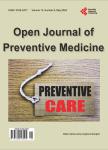Analysis and Prediction of the COVID-19 Pandemic in Senegal Using the SIR Model
Analysis and Prediction of the COVID-19 Pandemic in Senegal Using the SIR Model作者机构:Assane Seck University Ziguinchor Senegal
出 版 物:《Open Journal of Preventive Medicine》 (预防医学期刊(英文))
年 卷 期:2022年第12卷第12期
页 面:302-311页
学科分类:07[理学] 0701[理学-数学] 070101[理学-基础数学]
主 题:COVID-19 Senegal Basic Reproduction Number SIR Model
摘 要:In this study, the mathematical SIR model (Susceptible-Infected-Recovered (cured and deceased)) was applied to the case of Senegal during the first two waves of the COVID-19 pandemic. During this period, from March 1, 2020, to March 30, 2021, the transmission and recovery rates as well as the number of reproduction were calculated and analyzed for the impact of the decisions taken by the Senegalese government. In both waves, the variation of the basic reproduction number as a function of time, with values below one towards the end of each study period, confirms the success of the Senegalese government in controlling the epidemic. The results show that the solution of mandatory mask-wearing is the best decision to counter the spread of the disease. Indeed, the mean number of reproduction is 2.11 in the first wave, and the second wave has a lower mean value of 1.23, while the decisions are less restrictive during this latter wave. Also, a short-term prediction model (about 4 months) was validated on the second wave. The validation criteria of this model reveal a good match between the results of the simulated model and the COVID-19 data reported via the Ministry of Health, Solidarity, and Social Action of Senegal.



